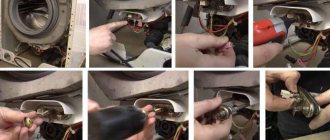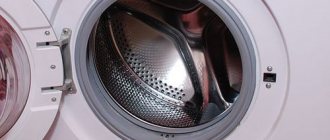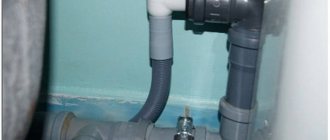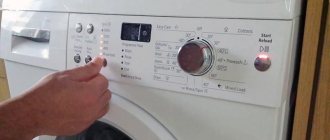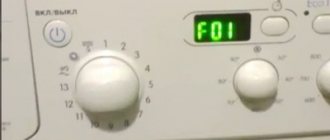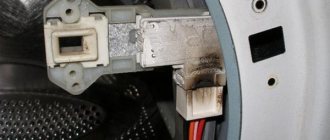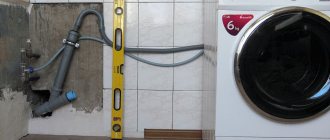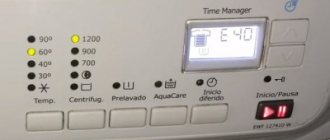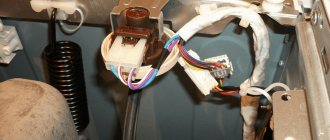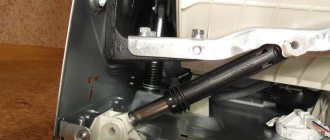What is the heating element of a washing machine? Location of the heating element in washing machines
Before disassembling the washing machine to get the heater, you need to determine where the heater is located in the washing machine.
It's not difficult - you just need to look at the back of the car and see how big the back cover is. If it is large, covering the entire wall, then most likely the heating element is located right behind it. Usually down under the washing tub.
In this case, removing the heating element is quite simple, since you just have to unscrew the back wall.
If the cover is small, then most likely it is a hatch to provide access to the machine belt. In this case, the heating element should be looked for at the front of the machine, behind the front panel. Disassembling it takes much longer and is more difficult than removing the back cover.
In any case, it is recommended to start by removing the back wall of the machine to understand where exactly the heater is located in this model. Moreover, it is completely easy.
If the instructions for the washing machine have not been preserved, then you can also be guided by the fact that for washing machines of the brands Zanussi (Zanussi), Kandy, Electrolux, Ariston, Indesit (Indesit), Virpul, Atlant, Beko (Veko), the heating element is usually located behind the back lid.
In Hans brand machines, in order to get the heating element, you need to remove the base panel. For this brand and for most machines that have a vertical principle of loading laundry, the heater is located on the side.
In washing machines of the Siemens, Samsung, Bosch, LG brands, in order to replace the heater, you will almost certainly have to remove the front decorative panel.
Before removing the heating element, it is necessary to drain the water from the machine, so you should prepare a rag and a container to collect the liquid in advance.
The algorithm for removing the heater is as follows:
- The wires leading to it are disconnected;
- The nut located in the middle of the heater is unscrewed;
- The threaded pin is pushed in - press it or hit it with a hammer (not too hard).
After this, by picking up the element with a knife or screwdriver, you can remove it. Sometimes this requires rocking it from side to side if the part is stuck.
How to find and dismantle a faulty heating element ↑
In modern automatic washing machines, heating elements are located at the bottom of the tank. Some manufacturers, including Bosch and Samsung, place them in the front, while others, including LG and Atlant, mount heating elements in the back.
Visually, the location of the heating element in front-loading machines is easy to determine by the size of the back cover: if it is large, then most likely the water heater is located behind it. If the model is equipped with a plinth panel, then the required part should be looked for behind this door. In units with vertical loading, it is most convenient to carry out repairs through the side wall.
Before dismantling a failed device, you should disconnect the equipment from the power supply and drain the remaining water in the system. After this, you can unscrew the screws holding the back cover and remove it. Do the same with the side wall and base panel.
For ease of operation, it is also recommended to remove the drive belt. Having discovered the heating element, it is necessary to free it from the power cables and grounding. If the heating element is equipped with a temperature sensor, then it must also be turned off.
To dismantle the heating device, it is necessary to loosen the nut on the central screw (as a rule, no more than six turns are enough) and push through the retaining screw. After this, the water heater is removed from the socket with little effort using two flat-head screwdrivers. In machines with plastic tanks, the process of removing the heating element goes without problems; with metal parts you will have to tinker a little longer
It is important to dismantle it carefully and without excessive pressure, so as not to damage the washing machine tank.
What is a dry heating element for a water heater? “Dry” heating element - design and features
The heating element of such a heating element is also a nichrome spiral. But it is not inserted into the tube and is insulated not with filler, but with ceramic insulators.
Dry heater appearance
Individually, its elements look like this:
Individual elements of a “dry” heating element
It is clear from the drawings that such a device cannot be immersed in water. It is not intended for contact with water, hence the name “dry”. The assembled heater is installed in a special flask made of metal or heat-conducting ceramics. The surface of the metal flasks is coated with anti-corrosion enamel.
"Dry" heater in a flask
And the flask itself is built into a heated container and insulated with gaskets. Unlike the wet version, both the flask and the heater itself are always made in a straight shape, without any bends. And the “dry” heating element is installed in the water heater only in the lower part of the tank.
Dry installation of a heater in a boiler
The fact that the heating element itself does not come into contact with the inner surface of the installation flask limits the rate of initial heating of the water. And although the gaps between the heating element itself and the wall of the flask are minimal, some time is still spent warming up the air gap. For this reason, current dry-type designs are not installed in instantaneous water heaters, and they are used only in storage water heating systems.
The most common causes of washing machine breakdowns
1. Wear of parts and elements. According to specialists from service centers that repair washing machines, the first failures begin due to wear and tear of functional parts, often expensive ones. Is it possible to somehow influence this? Yes. The main preventive measure is to prevent increased vibrations of the washing machine. All washing machines vibrate, but you should try to reduce the level of vibration.
To do this, it is necessary to correctly install the automatic machine on a flat, hard surface. If you doubt your own abilities, it is better to invite specialists who will level the machine, so that vibrations will be minimal.
However, strong vibrations can also occur due to improper operation of the washing machine : you should not tightly fill the drum with things - this will affect the quality of the wash and increase the vibrations. However, you cannot wash too few things - it will be difficult for the machine to distribute the load, which will also lead to prolonged increased vibrations. For the same reason, you cannot wash one heavy and several light items at the same time - load distribution will become a problem even for the smartest washing machine.
2. Clogged washing machine. More than once I have heard stories that after washing women's underwear, there was a need to take the washing machine in for repair . And the reason for this was the metal “bones” from the bra, which left their usual location during washing and slipped through the holes in the drum. Coins, paper clips, buttons, pins, keys, etc. can cause the same damage. Before loading things into the car, you need to carefully check them: turn out the pockets, see if the buttons and zippers are holding well. By the way, things should be washed fastened.
If a blockage occurs, the washing machine begins to make strange sounds during operation. You need to check the drum: maybe there is some metal object stuck in it.
It is also necessary to look into the contents of the sump pump filter and clean it at the same time. If nothing is found, and extraneous sounds continue to be present, you need to invite a specialist to your home.
3. Failure of the heating element of the washing machine . There is a persistent rumor among people that combustion of the heating element is the most common cause of failure of washing machines . Apparently, this was greatly facilitated by the advertising of powders that protect washing machine elements from scale. In fact, failure of the heating element is the third most common reason for a washing machine not working. Or rather, the machine works, but only washes in cold water. This, of course, is not the case - you need to install a new heating element. It is inexpensive, and the work to replace it is simple. By the way, according to statistics from some service centers, heating elements fail on average in the eighth year of service of the machine. Not so scary, right?
Why does the heating element of a washing machine break? First of all, due to the appearance of scale on it. The scale layer causes the element to overheat, which leads to its combustion. How to prevent scale from appearing on the heating element? Should I use Calgon regularly or use folk remedies? We'll talk about this later, but for now let's return to the causes of breakdowns.
Above are the most common reasons why a washing machine breaks down . There are, of course, failures in the “computer” of the washing machine, but this happens much less frequently. Problems with electrical wiring due to failure to comply with safety precautions are also common. Well, no one is immune from force majeure situations, for example, a washing machine falling or a power surge!
So, in order to prevent damage to the washing machine, you need to read the operating instructions and follow them. It is necessary to install the machine level and be careful when loading the drum, avoiding difficulties with load distribution and clogging with foreign objects. But how to protect the heating element and is it necessary?
TEN, what is it? Tubular electric heater
A tubular electric heater (TEH) is an electric heating device in the form of a metal tube filled with a heat-conducting electrical insulator. A conductive thread (usually nichrome or fechral) of a certain resistance passes precisely through the center of the insulator to transfer the required specific power to the surface of the heating element.
It is used in many household and industrial electrical appliances: kettles, boilers, washing machines, water heating and heating boilers, etc.
The PETN was invented and patented on September 20, 1859 by George B. Simpson in Washington, DC.
Double-ended heating element of an electric stove in the form of a spiral. Power regulation with a rheostatic switch or cyclic on-off over time
A single-end heating element of an electric stove in the form of a spiral with three heating threads of different resistance connected at the blind end of the heating element. Power regulation by combining current supply to the terminals with a switch (1 ~ 2 0; 1~30; 2~30; 1~2~30)
Tubular electric heaters can have different diameters ranging from 6 to 24 mm. Depending on the specific application (heating liquid or air), in the production of heating elements, electrical insulators (dielectrics) of various qualities are used, which must retain their dielectric properties at low, high and extremely high temperatures.
According to their configuration, heating elements are divided into double-ended (when the contact terminals are located on both sides) and single-ended (“cartridge”) - with contact terminals located on one side of the heater. Electric boilers usually contain blocks of heating elements, or, as they are also called, “TENB”.
How to determine where the heater is located
The heating element is located at the bottom of the tank. Depending on the manufacturer of the equipment, the heating element may be located in the front or rear of the housing. Most brands, such as Candy, Indesit, Zanussi, Ariston, Electrolux, Atlant, provide access to the heater through the back panel of the washing machine. Companies Samsung, Bosch, LG place heating elements in the front part, under the drum.
In washing machines from Samsung, Bosch and LG, the heater is usually located at the front
To determine the location of the part, you need to look at the size of the back panel of the machine. If there is a large removable surface at the back, then the heating element is most likely located there. If only a small cover can be unscrewed on the rear panel, then the exit to the heating element should be sought through the front panel. It is not always possible to determine the location of a part by external signs, so it is best to start looking for the location from the back - it is easier to remove it and screw it in place.
Heating element for a washing machine, what is it. How to choose a heating element for a washing machine
How to choose a heating element (heating element) for a washing machine according to the brand of equipment.
Seat
The most important thing when selecting a heating element is that the seat fits. Almost all heating elements have the same place. The exception is heating elements on old washing machines that are more than 12 - 13 years old.
Presence of a collar
The presence of a collar must be taken into account. If instead of a heating element that did not have a collar, you put a heating element with a collar, then this heating element may fly out of the tank during washing. In principle, it is possible to install a heating element without a collar in place of a heating element with a collar, but it is not advisable.
Hole for sensor
Some heating elements have a special hole for the sensor. On all heating elements that come with a sensor, this sensor can always be pulled out, even if it seems that it is sealed. Instead of a heating element without a hole, you can install a heating element with a hole using a special plug. There are models on LG washing machines that have heating elements with a sensor, but nothing is connected to the sensor. In this case, you can install a heating element without a hole.
Heating element length
After that there is a difference in length. Heating elements are short, medium and long. It is advisable to take the length into account, but if the new heating element is a little longer or shorter than the old one, then it’s okay. You can also install a short heating element instead of a long one, but a long heating element will not fit in place of a short one (it may not fit).
Heating element power
Next comes power. Power doesn't matter. If the heating element is more powerful, then it will heat the water a little faster, and if it is less powerful, then it will heat the water a little longer. The difference will not be noticeable.
Heating element shape
Another point is the shape of the heating element. Almost all heating elements are straight, but sometimes curved ones are found. This must also be taken into account.
Heating element coating
Some models of washing machines are equipped with heating elements with ceramic or other coatings. It is not of fundamental importance; it may last a little longer.
Manufacturers of heating elements
- Thermowatt (the best in quality, these heating elements are stamped “made in Italy”)
- IRCA (second in quality, but these heating elements come with a fuse)
- Blackmann (worse heating elements, very rare)
The manufacturer does not matter, the main thing is that the heating element fits other parameters.
Brand selection process
- Samsung, Indesit, Ariston - short heating elements with a hole, without a collar. Some Samsungs have ceramic heating elements. Instead of them, you can install ordinary short heating elements with a hole.
- LG – short heating elements without holes. Some models come with heating elements with sensors.
- Bosch, Siemens - medium heating elements with a collar and a hole.
- Candy – long heating elements without a hole, with a collar.
- Electrolux, Zanussi - long heating elements with a hole, with a collar.
- Ardo - sometimes there are curved heating elements with or without a hole.
- Older models of the brands listed above may have other heating elements. Basically, long heating elements were installed in the past. There may or may not be a hole for the sensor.
This list is indicative only. Discrepancies are possible!
Signs that the heating element has burned out
- The washing machine does not heat the water
- The washing machine fills with water and stops or turns off after 5 minutes
- 5 minutes after the washing machine starts working, the plugs break out
- The smell of burning
- The washing machine does not wash well
- The washing machine is electrocuted
In our catalog of spare parts for washing machines, you can select the appropriate heating element for your washing machine based on the brand or size of the heating element. You can order a spare part on our website, or by calling.
Another important part of an automatic washing machine is the heating element.
catalog section: Heating elements (heating elements) for washing machines
From the very beginning, SMAs were created with the expectation that they would be able to do all the things related to washing and drying themselves. And therefore it is clearly felt that this could not have happened without a heating element. Because, if not him, then who could organize the heating of water to the required temperature? How would drying clothes be possible without it? And this is precisely why automatic machines always have a heating element - one of the most important parts of washing equipment.
Heating elements of washing machines and their structure
From the very beginning, it must be said that if the SMA “can” both heat water and dry clothes, then it means that it has two heating elements. A heating element, which is designed to heat water, is installed at the bottom of the tank, while to organize drying, a heating element is used in the so-called “drying chamber”.
A heating element for a washing machine is a tubular heater (electric) capable of converting electrical energy into heat. As soon as the washing equipment is connected to the electrical network, electricity passes through its heating device (or rather, through an electric coil inside the device, pressed into a stainless tube along with quartz sand), heating the water to the required temperature. And the connection of the heating element itself occurs through terminals made like plates for contact clamps. There are also threaded terminals - it all depends on the model of the washing machine.
By the way, the electric spiral, located inside a stainless tube, is made of a thermoelectric alloy, which makes it possible to withstand not only a long standard load, but also short-term overloads (this may be due to surges in electrical voltage). If we talk about the place where the heating device is attached, it turns out that there must be a sealing plastic gasket there.
Design features of heating elements of automatic machines
It doesn’t hurt to know that heating elements for heating water are similar in design, but may differ due to various factors: power, length, bending angle of the heating element, location of terminals, presence/position of a hole for a temperature sensor. Let's look at all these parameters.
If we start the comparison with power, we find out this: the most economical heating devices consume power within 800 W, and the most voracious - up to 3000 W. Speaking about the length of heating elements, it is necessary to indicate that they can be long, short and medium in length. So a short heating element is a heating element starting from 15 cm, and the longest one is within 30 cm. As mentioned above, heating elements of washing machines also differ in the bending of the heating element. If, as a rule, they all have a spiral shape, then their bending angle can vary from 15 to 45 degrees (there are certain types that even exceed this parameter).
There is also a difference in the terminals: standard models have one terminal on each side, while SMAs such as, say, Bosch have two on each side.
It is worth pointing out such a difference as a heating element for a metal tank and a heating element for a plastic one. For iron tanks, heating devices are made with a rubber band about 1.5 cm long (or even less), and for a plastic tank - more than the specified parameter. And all because the plastic tank has thicker walls.
You shouldn’t ignore such a distinctive feature, which is special. sensor hole. If provided, it is located in the metal base of the heating element. You must understand that if you suddenly need to purchase a new heating element, then you should definitely take this feature into account - buy only a heating element with a hole for the sensor.
Water as the main factor against heating elements
Heating elements come into contact with water - this goes without saying, so it is not surprising that their breakdown occurs primarily due to the appearance of scale. This is akin to scale in a kettle, only here everything is more serious and in greater volume, because scale on the heating element is a “bouquet” of various undesirable impurities. When the limit of “tolerance” of the heating device is reached, it informs its owners this way: the heating capacity decreases, more electricity and powder are spent on washing, and the laundry does not sparkle with ideal cleanliness. In general, everything is not the same as it was before.
If all these signals are ignored and operation continues, then huge troubles on a global scale are possible - breakdown of other important parts of the automatic machine and its complete failure. To prevent this from happening, try to contact specialists in a timely manner, whose repair service is at the highest level in terms of knowledge of the problems not only of SMAs, but also of other household appliances.
SMA heater service life
During normal operation, the service life of the heating element can be from 5 to 10 years. But if you create unfavorable moments, it will fail before the specified first date. And what could provoke such an exit? This:
- Manufacturing quality of the SMA itself and its parts;
- Washing frequency and temperature;
- Hardness of water.
But most of all, the “life” of an automatic machine, like its parts, depends on quality. And if you always want to be sure that any household appliances are only from a recognized manufacturer, then do not be lazy to purchase them in specialized centers. It is these stores that can provide all warranties for their products, as well as help with the selection of any spare parts, accessories and installation fittings.
catalog section: Heating elements (heating elements) for washing machines
What is a heating element in a washing machine? Heating element for washing machine
Among the main elements of a household washing machine, a special role is given to the heating element. If it fails, the equipment stops working properly. The malfunction of this element is the main reason for contacting the repair service.
What is a heating element in a washing machine, the main function
A tubular electric heater is a tube with a spiral inside, which consists of a heat-conducting insulator and a conductive thread. The curved tube of the heating element is attached at both ends to the flange. A special gasket on the flange allows for a tight installation when tightening the nut. In order to securely fix the heating element, it is necessary to perform the installation correctly.
The main function of the heating element is to heat water to a certain temperature set by the washing mode.
Failure of the tubular electric heater is the main cause of errors or program freezes. If the washing machine does not heat the water, then the heating element is most likely to blame.
The service life of an important element is influenced by many factors:
- part quality;
- hardness of water;
- washing temperature.
- The heating element often breaks due to the formation of a thick layer of scale on it.
Modern types of heating elements
Different heating elements differ from each other in the following parameters:
- length;
- bending;
- power;
- terminals;
- the presence or absence of a hole made specifically for the sensor;
- brand;
- for which tanks (plastic or iron).
1. The length of the heating element can be different. There are short models on the market (15 - 16 cm), medium (17 - 19 cm) or long (20 - 30 cm).
2. The power of the part varies from 1,600 to 2,200 W. Here heating elements can also be short (1,600 – 1,800 W) and long (1,800 – 2,000 W). The power determines how quickly the machine will heat up.
3. According to their bending, heating elements are divided into spiral and curved. It is necessary to take into account the amount of bending in degrees: 15, 30, 45 and more.
4. There is a hole for the sensor on the heating element at the base of the heating element. This element can only be replaced with a part with a hole. If it is not in the heating element, then a similar model is purchased.
5. Intended use for a tank made of a certain material means that you can determine the appropriate heating element for a particular washing machine based on the length of the elastic band that is needed to attach the heating element. If its size is 1.5 cm or less, then it is perfect for an iron tank. If the elastic band in the model exceeds 1.5 cm, then it is used for plastic tanks.
6. The brand that produced the heating element must be taken into account. For washing machines from Europe (Austria, Germany, Italy), it is recommended to purchase heating elements from European manufacturers. If the part was manufactured in Asia, then it is better to consult your sales manager. So, for a German BOSCH washing machine, the best solution is a BOSCH TEN!
How to clean the heating element in a washing machine yourself
Timely cleaning of the washing machine will help maintain its performance for a long time. The insidious scale can cause enormous harm. It is formed when the heating element heats the water. Potassium and magnesium salts break down, forming carbon dioxide and a precipitate called scale.
Today there are washing powders on sale that soften hard water and improve its quality: they contain acid. During the washing process, it can dissolve scale, so when choosing the right product, you don’t have to worry about the cleanliness of your household appliance.
Owners of washing machines who previously did not know about special powders and did not use them can take advantage of the opportunity to clean the heating element with citric acid. To do this, you will need to perform a series of sequential actions:
- 200 g of citric acid is poured into the laundry tank.
- The main wash program is set at maximum temperature.
- The washing machine turns on.
While household appliances are running, the acid cleans not only the heating element, but also the inner surface of the drum and tank. The housewife can make cleaning more effective if she adds an additional 200 g of bleach. This procedure will return the washing machine to its original condition. The owner of Zanussi equipment will never face the problem of washed clothes. Cleaning should be done every 2 months. However, there are also disadvantages here. When citric acid is used constantly, it can destroy not only limescale, but also rubber parts.
Other common problems include leaking drain hoses. Only replacing the faulty element will help eliminate the leak. Before you make a purchase, you need to study the advantages and disadvantages of different models of drain pumps. After analyzing all the possible offers, the owner of the washing machine will make the best choice.
The design and principle of operation of the heating element
The heating element in a washing machine is an element that heats water to the required temperature in various washing programs. In warm or hot water, the chemical reagents of the washing powder react best with various types of contaminants, which leads to high-quality washing of clothes. For some fabrics, washing modes are provided only in cold water, so the heating element is not included in the work in such cases.
A heating element for a washing machine looks like a curved tube, inside of which a nichrome or fechral wire is placed. The space between the walls of the tube and the conductive thread is filled with a dielectric, which has sufficient thermal conductivity and resistance to high temperatures.
The most commonly used electrical material is peraclase (magnesium oxide). The heating element tube is soldered or welded to the contact pad on which the current-carrying terminals are mounted. Typically, contacts are made of copper plates for clamping. The length of the rods and the type of contact pad in washing machines may vary, but the general structure and operating principle are the same.
When an electric current passes through a filament with high resistance, it becomes very hot. Heat passing through the dielectric material and the metal tube is released into the environment. In a washing machine, this medium is water. As a result, the water temperature rises to the required value for a specific washing program, and then the heating element turns off.
A special temperature sensor (thermistor) is installed in the tank or heating element, which sends a signal to the control board when the required temperature is reached. The processor processes the signal and interrupts the voltage supply to the heating element. The processor also receives a signal from the water level sensor in the tank (pressure switch). It informs the central processor about the presence of water in the washing tank, and the temperature relay about its temperature. If necessary, the control processor turns on the heating element. In washing machines with electronic control, an electronic module is responsible for the operation of the heating element; in models with electromechanical control, a programmer is responsible.
Dry heating element water heater, what is it. Features of water heaters with wet heating elements
This type of heating part is one of the most popular and widespread. The wet heating element works directly with liquids. Direct interaction can negatively affect the part itself. Unlike the dry type, scale marks appear faster on the wet type and metal corrosion will occur. They include the following elements in their design:
- Metal tube
- Spiral
- Dielectric filler (it prevents electrical overvoltage)
Despite the fact that boilers have their negative sides, the quality of heating in mechanisms with a wet heating element does not change. In addition, they have other positive qualities, such as price. An open type device will cost several times less than a closed one. Additional equipment for the mechanism also costs less. A good example of this type of heaters is the products of THERMEX. If problems arise, a specially built-in tube will help drain all the water to begin repair work.
Tip: Any heating element will work with such devices; you won’t have to look for a part for a specific model.
How to replace the heating element
Before starting repairs, you need to completely drain the water from the machine and disconnect it from the mains. To carry out the work, you must have a screwdriver and an 8 or 10 inch wrench on hand. After this, you can start replacing.
First you need to determine the location of the heating element. Where the heating element can be located depending on the model and structural features of the washing machine is described above. Having reached the water heating system, the user will see only the outer part of the heating element - the terminals and wires, which must be disconnected before removing the heating element.
Before removing the heating element, you need to disconnect the terminals and wires connected to it
To get the heater you need to:
- unscrew the central nut using a socket wrench;
- using a screwdriver, insert the bolt into which the nut was screwed;
- Carefully pick up the heating element with a screwdriver and smoothly loosen it up and down and remove it from the rubber seal.
The faulty part should be repaired or replaced with a new one. When purchasing a new heater, you should know the exact markings of the previous one.
It is important to install the working heater in its place, ensuring an accurate and tight fit of the element. When the heater is installed, tighten the nut and connect the wires to the terminals.
It is important to install the heating element back correctly, achieving an accurate and tight fit
Without closing the wall, check the operation of the heating element. To do this, you need to run a washing program with water heating at least +60 ℃ and after 10-15 minutes touch the loading hatch window. If it is warm, it means the water is heating up and the heating element is properly performing its function. After this, you can install the panel in place.
Replacing the heating element on a washing machine is carried out according to a common algorithm for all brands. The difference may only be differences in access. It is not difficult to replace the heater yourself if you have the necessary tools and clear instructions for action at hand.
What is a heating element in an oven? Communicate with ovens in the same language
When a housewife gets acquainted with a new oven, the first thing she encounters is the need for translation.
And not in the sense from one language to another, but more often from the names inherent in each company to generally accepted terms. What is it for? It's simple, you can compare one oven with another only when the object of comparison is clear. Therefore, we avoid pretentious, and most importantly, incomprehensible expressions such as “turbo air”, “maxi-grill”, “intense hot air”, “thermal circulation” or “3-0 convection”. And if the description includes some function like “slow baking” or “gratin”, we strive to “shake” the whole truth from the brand department about how it works.
Therefore, the technical characteristics in manufacturers’ catalogs look much brighter and more seductive than our boring, but understandable data. We will not deviate from this rule now, so we assign the same names to the modes that you will see on the following pages of the review.
Don't forget to reheat
At the beginning of the story - some general advice. In the instructions for ovens (which we actively use), for successful cooking, it is recommended to preheat them to the required temperature (we focus on the thermostat indicator lamp; it should go out).
Only for very fatty meat can you make an exception and put it in a cold oven. In this case, the cabinet can be turned off a few minutes before it is ready; the residual temperature will be sufficient for the successful completion of the process. It is advisable to open the door as little as possible, and observe the “behavior” of the products through the glass (this is why the backlight often does not turn off while cooking is in progress).
What is a heating element? Advantages of heating elements
Compared to other types of heaters, heating elements have many advantages.
For example, they can also be used when there is direct contact of the heater with the heated medium. And, as you know, these can be a wide variety of options, not just liquid and gaseous. The medium can even be solid, and the pressure in it can reach up to 4.5 atm. And this will not become an obstacle for the heating element. The advantage of tubular electric heaters is their reliable operation during vibrations, as well as when there are significant shock loads. In addition, they have different configurations. And there is no voltage on the shell of the heating elements.
There is such an important indicator as mean time to failure. When using heating elements to heat air media, it is at least 10 thousand hours. When used to heat liquid media – at least 5 thousand hours.
A double-ended round heating element has a design where the heating element is located inside a metal shell. This is, for example, a spiral or several spirals made of a high-resistance alloy. There are also contact rods there.
The compressed electrical insulating filler serves as an insulator between the shell and the heating element. In order to prevent moisture from entering from the environment, the ends of the heating elements are sealed. There are also dielectric insulators between the contact rods and the shell.
Heating element with thermostat. A heating element with a thermostat will heat the water safely and quickly
Heating elements with a built-in thermostat are found almost everywhere where water heating is needed, from factory boilers to homemade convectors made from a cast iron radiator. What advantages and disadvantages does this device have? Let's figure it out.
How it works and how to choose
A heating element with a built-in thermostat has a simple structure, consisting of two parts, a heating element and a temperature sensor connected to a temperature controller. But even here there are several features that significantly affect the serviceability and service life of the device.
- The first thing you should look at when buying is its body. A more durable heating element will be made of copper and have a corresponding noble color; a cheaper option is usually made of “acid-resistant stainless steel”. There is no way to verify how durable this stainless steel really is in the store, so give preference to the brass version of the case. The outer diameter of the tube is usually 13 mm, but there are also thin, low-power options - 10 and even 8 mm;
The steel body of the heating element with a thermostat is usually a little cheaper
The copper heating element body gives more hope for long-term operation - Marking.
Since we are considering a heating element for a water heater, you should make sure that in the marking, before the designation of the operating voltage 220V, there is the letter “P”, indicating operation in water and weak alkaline solutions; Symbols on the heating element body - Power. It should be taken into account that when connecting to a regular home network, you should not use a heating element more powerful than 2.5 kW - this puts too much load on the regular wiring. If you plan to connect a more powerful heating element with a thermostat, lay a separate cable from the panel with the appropriate cross-section to the installation site.
- The temperature sensor is located in a separate tube and, if necessary, is removed from it along with the thermostat. Svidu is a rod. It contains a thermocouple inside, which, when heated, activates the thermostat mechanism. Often, the failure of the temperature sensor causes the heating element to turn off at low temperatures.
To make your washing machine last longer
A washing machine from any manufacturer or brand can have its service life extended by a couple of years. To do this, follow these recommendations:
- Do not forget to unplug the device from the outlet after each wash. This way you will protect your equipment from power surges and breakdowns.
- Wash the machine after each cycle and wipe dry. Leave the laundry hatch and powder container open to dry. The fungus does not settle on dry, clean surfaces.
- Strictly follow the manufacturer's basic operating recommendations.
- Always drain remaining water through the drain hose to avoid stagnation and unpleasant odors.
- Carry out preventive washing with citric acid a couple of times a month. Do you often wash at high temperatures? Prevention will be required no more often than once every 2 months.
- If your tap water is very hard, don't forget to add a softener.
- Clean or change the main filters at least once a year.
- When making repairs, use only original spare parts.
Household appliance repair technicians know cases where, with careful care, washing machines served their owners for 20 or even 30 years.
You can regularly care for your home assistant, but you cannot influence the service life if there is a manufacturing defect or force majeure.
From all of the above we will draw conclusions. The service life of the washing machine depends on the quality of assembly and parts, as well as proper care, and ranges from 3 to 20 years. The average operating time of modern machines is from 5 to 10 years. Choose reliable equipment from trusted brands. Use your device carefully for many years to come.
The heating element of a washing machine is an electric heating element made of stainless steel, which has a heating coil with an insulation layer inside the tube.
The heating element is used to heat the water during washing, which allows you to wash things as efficiently as possible. Also, detergents and surfactants in laundry detergent dissolve much better in hot water. Structurally, the service life of the heating element is practically unlimited, but as practice shows, it is the heating element in the washing machine that fails very often. A more likely cause of failure of the heating element is the formation of scale.
A feature of domestic water is its very high (unstandardized) content of mineral salts. Salts are contained in water in a dissolved state, so installing various filters and adding water softeners do not lead to the expected result. When heated, the salts contained in the water fall out on the heating element tube and settle in the form of a durable layer of scale. The mass of deposits is constantly growing. As a result, aggressive scale provokes metal corrosion with subsequent breakdown of the heating element onto the body. In this case, the electronics unit (board) of the washing machine may even fail.
Another scenario is that such a layer of scale settles that, due to deterioration of heat transfer and internal overheating, the heating element coil burns out. It also happens that when overheating, the heating element tube ruptures, water gets inside through the rupture and a breakdown occurs on the housing, which in turn can damage the electronics unit (board), the cost of which can be very high.
